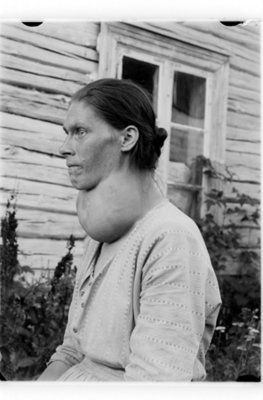Goitre: Difference between revisions
No edit summary |
No edit summary |
||
| Line 16: | Line 16: | ||
{{SI}} | {{SI}} | ||
{{GS}} | {{GS}} | ||
==Overview== | ==Overview== | ||
| Line 91: | Line 89: | ||
[[sv:Struma]] | [[sv:Struma]] | ||
[[ta:முன்கழுத்துக் கழலை]] | [[ta:முன்கழுத்துக் கழலை]] | ||
[[Category:Mature chapter]] | |||
{{WikiDoc Help Menu}} | {{WikiDoc Help Menu}} | ||
{{WikiDoc Sources}} | {{WikiDoc Sources}} | ||
Revision as of 00:51, 29 July 2011
For patient information click here
| Goitre | |
 | |
|---|---|
| a woman with a goitre | |
| ICD-10 | E01.0-E01.2 |
| ICD-9 | 240.9 |
| DiseasesDB | 5332 |
| MedlinePlus | 001178 |
| MeSH | Goiter |
|
WikiDoc Resources for Goitre |
|
Articles |
|---|
|
Media |
|
Evidence Based Medicine |
|
Clinical Trials |
|
Ongoing Trials on Goitre at Clinical Trials.gov Clinical Trials on Goitre at Google
|
|
Guidelines / Policies / Govt |
|
US National Guidelines Clearinghouse on Goitre
|
|
Books |
|
News |
|
Commentary |
|
Definitions |
|
Patient Resources / Community |
|
Directions to Hospitals Treating Goitre Risk calculators and risk factors for Goitre
|
|
Healthcare Provider Resources |
|
Continuing Medical Education (CME) |
|
International |
|
|
|
Business |
|
Experimental / Informatics |
Editor-In-Chief: C. Michael Gibson, M.S., M.D. [1] Phone:617-632-7753
Overview
A goitre (BrE), or goiter (AmE) (Latin struma), also called a bronchocele, is a swelling in the neck (just below Adam's apple or larynx) due to an enlarged thyroid gland.
Classification
They are classified in different ways:
- A "diffuse goitre" is a goitre that has spread through all of the thyroid (and can be a "simple goitre", or a "multinodular goitre").
- "Toxic goitre" refers to goitre with hyperthyroidism. These most commonly due to Graves disease, but can be caused by inflammation or a multinodular goitre.
- "Nontoxic goitre" (associated with normal or low thyroid levels) refers to all other types (such as that caused by lithium or certain other autoimmune diseases).
Causes
Other causes are:
- Hashimoto's thyroiditis (E06.3)
- Graves-Basedow disease (E05.0)
- inborn errors of thyroid hormone synthesis, causing congenital hypothyroidism (E03.0)
- Thyroiditis (acute, chronic) (E06)
- Side-effects of pharmacological therapy (E03.2)
- Thyroid cancer
- Iodine deficiency
Occurrence
Iodine is necessary for the synthesis of the thyroid hormones triiodothyronine and thyroxine (T3 and T4). In conditions producing endemic goitre, when iodine is not available, these hormones cannot be made. In response to low thyroid hormones, the pituitary gland releases thyroid stimulating hormone (TSH). Thyroid stimulating hormone acts to increase synthesis of T3 and T4, but it also causes the thyroid gland to grow in size by increasing cell division.
Goitre is more common among women, but this includes the many types of goitre caused by autoimmune problems, and not only those caused by simple lack of iodine.
Treatment
Treatment for goitre may not be necessary if the goitre is small. Hypothyroidism should be treated, and this treatment often leads to a substantial reduction in the size of the goitre. Removal of the goitre may be necessary if it causes difficulty with breathing or swallowing. There is now an alternative to surgery in large goitres. Radioiodine therapy with or without the pre-injection of a synthetic thyroid stimulating hormone, TSH, can relieve obstruction and reduce the size of the goitre by 30-65%. But removal of a goitre requires removing the thyroid. The complete removal of the thyroid gland removes the body's ability to produce thyroid hormone. In this case, oral thyroxine supplements are necessary to avoid harm from hypothyroidism.
History and future
Paracelsus (born Philippus Aureolus Theophrastus Bombastus von Hohenheim) (1493–1541) was the first to describe the connection between goitre and the consumption of minerals, specifically lead in drinking water.[1]
Goitre was previously common in many areas that were deficient in iodine in the soil. For example, in the English Midlands, the condition was known as Derbyshire Neck. In the United States, goitre was found in the Great Lakes, Midwest, and Intermountain regions. The condition now is practically absent in affluent nations, where table salt is supplemented with iodine. However, it is still prevalent in India,[2] Central Asia and Central Africa.
Some health workers fear that a resurgence of goitre might occur because of the trend to use rock salt and/or sea salt, which has not been fortified with iodine.
New research indicates that there may in fact be a tendency to inherit an increased vulnerability to goitre.
See also
- Struma ovarii (a kind of teratoma)
References
- ↑ "Paracelsus" entry in Dictionary.com, retrieved October 9, 2007
- ↑ "In Raising the World’s I.Q., the Secret’s in the Salt", article by Donald G. McNeil, Jr., December 16, 2006, New York Times
External links
- National Health Services, UK
- Network for Sustained Elimination of Iodine Deficiency
- Network for Sustained Elimination of Iodine Deficiency - alternate site at Emory University's School of Public Health
ar:تورم درقي
bs:Strume
da:Struma
de:Struma
eu:Bozio
id:Gondok
it:Gozzo endemico
he:זפקת
no:Struma
fi:Struuma
sv:Struma
ta:முன்கழுத்துக் கழலை